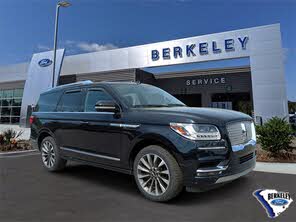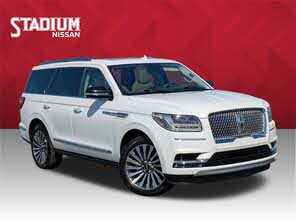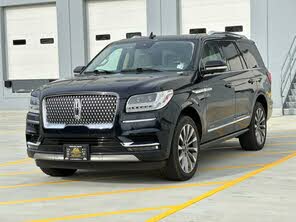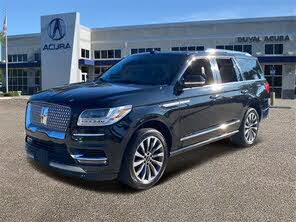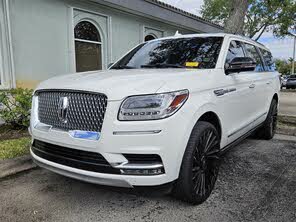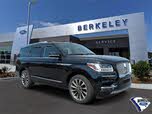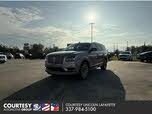2021 Lincoln Navigator vs 2020 Lincoln Navigator
Overview | |
MSRP$76,185 | MSRP$76,705 |
Average price$42,583 | Average price$49,394 |
Listings308 | Listings345 |
Ratings & Reviews | |
User Reviews | User Reviews |
Expert reviews8.2 out of 10 | Expert reviews7.7 out of 10 |
Pros
| Pros
|
2020 Lincoln Navigator Reviews SummaryFrom an impressive customer care program to a lineup of luxury vehicles focused on catering to and coddling its clients, Lincoln is carving a niche for itself in a space the automaker has referred to as “quiet luxury.” With the discontinuation of both the Continental and MKZ sedans after the 2020 model year, Lincoln will now rely on a lineup of four SUVs to continue its quest for success. Of those SUVs, the 2020 Lincoln Navigator is the flagship setting the course for the future. | |
2021 Lincoln Navigator Reviews SummaryFull-size SUVs like the Lincoln Navigator represent the smallest slice of the luxury SUV market. They're the heaviest, hugest, and fanciest people movers sold by mainstream automakers—and you can count them all on two hands. The Navigator, a popular nameplate since 1998, was redesigned in dramatic fashion for 2018. In its fourth model year, this Navigator still delights us as we test newer competitors costing at or above its $77,000 starting price. Foreign nameplates offer no equal to the Navigator, and it's not for sheer size or a desire to lift up Lincoln that we say this is one of the best American vehicles, among both trucks and cars, ever made. | |
No video found | No video found |
Popular Features & Specs | |
Engine3.5L 450 hp V6 | Engine3.5L 450 hp V6 |
Drive Train4X2 | Drive Train4X2 |
Seating Capacity8 | Seating Capacity8 |
Horsepower450 hp @ 5500 rpm | Horsepower450 hp @ 5500 rpm |
MPG City16 | MPG City16 |
MPG Highway22 | MPG Highway22 |
Engine | |
Engine Name3.5L 450 hp V6 | Engine Name3.5L 450 hp V6 |
Torque510 lb-ft @ 3000 rpm | Torque510 lb-ft @ 3000 rpm |
Horsepower450 hp @ 5500 rpm | Horsepower450 hp @ 5500 rpm |
Drivetrain4X2 | Drivetrain4X2 |
Fuel Economy | |
MPG City16 | MPG City16 |
MPG Highway22 | MPG Highway22 |
Interior | |
Leather SeatsStandard | Leather SeatsStandard |
Seating Capacity8 | Seating Capacity8 |
Key Features | |
Navigation SystemStandard | Navigation SystemStandard |
Safety | |
Front Crash Overall5 | Front Crash Overall5 |
Side Crash Overall5 | Side Crash Overall5 |
Dimensions & Capacity | |
Cargo Space20.9 cu ft | Cargo Space20.9 cu ft |
Curb Weight5673 lbs | Curb Weight5673 lbs |
Height76.4 in | Height76.4 in |
Length210.0 in | Length210.0 in |
Width93.8 in | Width93.8 in |
Wheelbase122.5 in | Wheelbase122.5 in |
Maximum Payload1620 lbs | Maximum Payload1620 lbs |
Number of doors4 | Number of doors4 |
Maximum Towing Capacity8600 lbs | Maximum Towing Capacity8600 lbs |
Standard Towing Capacity6200 lbs | Standard Towing Capacity6200 lbs |
Overview | ||
MSRP | $76,185 | $76,705 |
Average price | $42,583 | $49,394 |
Listings | ||
Ratings & Reviews | ||
User reviews | ||
Expert reviews | 8.2 out of 10Read full review | 7.7 out of 10Read full review |
Pros & cons | Pros
| Pros
|
Summary | From an impressive customer care program to a lineup of luxury vehicles focused on catering to and coddling its clients, Lincoln is carving a niche for itself in a space the automaker has referred to as “quiet luxury.” With the discontinuation of both the Continental and MKZ sedans after the 2020 model year, Lincoln will now rely on a lineup of four SUVs to continue its quest for success. Of those SUVs, the 2020 Lincoln Navigator is the flagship setting the course for the future. | Full-size SUVs like the Lincoln Navigator represent the smallest slice of the luxury SUV market. They're the heaviest, hugest, and fanciest people movers sold by mainstream automakers—and you can count them all on two hands. The Navigator, a popular nameplate since 1998, was redesigned in dramatic fashion for 2018. In its fourth model year, this Navigator still delights us as we test newer competitors costing at or above its $77,000 starting price. Foreign nameplates offer no equal to the Navigator, and it's not for sheer size or a desire to lift up Lincoln that we say this is one of the best American vehicles, among both trucks and cars, ever made. |
Video | No video found | No video found |
Popular Features & Specs | ||
Engine | 3.5L 450 hp V6 | 3.5L 450 hp V6 |
Drive Train | 4X2 | 4X2 |
Seating Capacity | 8 | 8 |
Horsepower | 450 hp @ 5500 rpm | 450 hp @ 5500 rpm |
MPG City | 16 | 16 |
MPG Highway | 22 | 22 |
Engine | ||
Engine Name | 3.5L 450 hp V6 | 3.5L 450 hp V6 |
Torque | 510 lb-ft @ 3000 rpm | 510 lb-ft @ 3000 rpm |
Horsepower | 450 hp @ 5500 rpm | 450 hp @ 5500 rpm |
Drivetrain | 4X2 | 4X2 |
Fuel Economy | ||
MPG City | 16 | 16 |
MPG Highway | 22 | 22 |
Interior | ||
Leather Seats | Standard | Standard |
Seating Capacity | 8 | 8 |
Key Features | ||
Navigation System | Standard | Standard |
Safety | ||
Front Crash Overall | 5 | 5 |
Side Crash Overall | 5 | 5 |
Dimensions & Capacity | ||
Cargo Space | 20.9 cu ft | 20.9 cu ft |
Curb Weight | 5673 lbs | 5673 lbs |
Height | 76.4 in | 76.4 in |
Length | 210.0 in | 210.0 in |
Width | 93.8 in | 93.8 in |
Wheelbase | 122.5 in | 122.5 in |
Maximum Payload | 1620 lbs | 1620 lbs |
Number of doors | 4 | 4 |
Maximum Towing Capacity | 8600 lbs | 8600 lbs |
Standard Towing Capacity | 6200 lbs | 6200 lbs |
The 2020 Lincoln Navigator boasted a distinctive and captivating exterior. Designers crafted a vehicle that stood apart from its Ford Expedition roots by incorporating unique front and rear styling elements, along with the Lincoln Embrace lighting system, which sequentially illuminated the SUV as its owner approached. The Navigator's exterior featured a lattice-type grille insert reflecting the Lincoln star logo, an illuminated star in its center, fender vents, simulated exposed door hinges, and full-width taillights, all combining to exude luxury and prominence. Black roof pillars further accentuated its sophisticated, wraparound glass appearance.
Additionally, the 2020 model introduced the Reserve Monochromatic Package, available in White, Ceramic Pearl, and Infinite Black. This package included body-color grille and side mirror treatments, paired with 22-inch black-painted wheels, enhancing the vehicle's bold and custom look. Buyers had the freedom to choose among various trims: the standard Navigator, the high-end Black Label, and the mid-range Reserve (with the Monochromatic upgrade). Options between standard and long-wheelbase (Navigator L) body styles, along with RWD and 4WD, provided extensive customization.
The interior of the 2020 Navigator matched its exterior's opulence. The test model came with the Reserve Monochromatic package, costing $92,385, which included 30-way Perfect Position seats in Dark Slate leather—equipped with heating, ventilation, and massaging functions—mid-century modern dashboard styling, a panoramic glass roof, and a high-quality materials blend. Digital instrumentation, a 10-inch infotainment touchscreen, and piano-key transmission controls set it apart from the Expedition, cementing its status as a luxurious flagship SUV.
In comparison, the 2021 Lincoln Navigator maintained its elegance while pushing boundaries of sophistication. It proudly stood as an independent model, shedding the Ford Expedition's image, except for shared side glass, rear seat shape, and overall footprint. The 2021 Navigator, especially in the Reserve trim tested, justified its $92,000 price tag with striking features that rivaled even prestigious brands like Mercedes and Land Rover.
Defining elegance and understatement on a massive three-ton vehicle, the 2021 Navigator employed simple rectilinear shapes for the grille, windows, headlights, and taillights. Chromed door trim, grille, and fender logos added a touch of class. Our Pristine White test model featured the Monochromatic package with white-painted grille, black wheels, and an illuminated Lincoln logo, presenting a distinguished appearance during winter tests. The "Lincoln light show" when locking or unlocking the remote, and the power running boards' illumination, enhanced its grandeur.
The interior of the 2021 model brought seven color palettes, including the elegant Slate Gray of our test vehicle. Features like layered wood trim behind the touchscreen, push-button gear selector blending into the center stack, chromed switches on the floating console, and a minimalist digital instrument panel contributed to a modern, muted aesthetic. Materials were top-notch, and panel gaps were minimal. The Black Label trim elevated the interior experience with varied textures, softer leather, and wilder design options.
The 2020 Lincoln Navigator featured a robust twin-turbocharged 3.5-liter V6 engine, producing 450 horsepower and 510 lb-ft of torque—surpassing the Ford Expedition's performance by 50 horsepower and 30 lb-ft of torque. Power was transferred through a 10-speed automatic transmission to the rear wheels, or optionally to all four. The Lincoln Drive Modes, including Conserve, Normal, Excite, Slippery, Deep Conditions, and Slow Climb, tailored the drivetrain for various conditions and driving experiences.
The Navigator's RWD model boasted a maximum towing capacity of 8,700 pounds, while the 4WD version offered 8,300 pounds. The Pro Trailer Backup Assist system simplified reversing with a trailer by steering based on input from a dashboard knob. Acceleration was strong, with the V6 engine's note subtle yet assertive from the driver's seat. Despite a lack of the V8 rumble, the powertrain delivered satisfactory performance, averaging 16.4 mpg on the testing loop, slightly below the EPA's 18 mpg combined rating.
However, the 22-inch wheels and adaptive damping suspension struggled with harsh impacts on uneven pavement, particularly in Excite mode. The Navigator excelled in body motion control, lending it an athletic touch, though best suited for smooth, open roads due to its sizable frame. Maneuvering in tight spaces seemed daunting, but the tight turning radius, parking assist, and comprehensive camera views aided navigation in crowded areas. The automatic hold function proved useful in heavy traffic.
Similarly, the 2021 Lincoln Navigator retained the 3.5-liter twin-turbo V6 engine from the high-performance Ford Raptor, generating an equally impressive 450 horsepower and 510 lb-ft of torque. Matched with a 10-speed automatic transmission, the Navigator felt remarkably agile for its size, with a pleasing intake snarl and turbo woosh enhancing the driving experience. The 4WD system offered seamless transition between RWD and 4WD High, outperforming GM competitors.
Towing capacity matched the 2020 model, with the RWD model pulling 8,700 pounds and 4WD model pulling 8,300 pounds. Fuel economy remained a downside, averaging in the teens, consistent with the EPA-estimated 17 mpg combined rating (16 city, 20 highway). The adaptive dampers in the 2021 model felt rudimentary compared to Cadillac Escalade's magnetic shocks and air springs, failing to deliver a supple ride on rough roads. Steering and braking lacked the precision found in the Escalade, though the Navigator managed to maintain adequate control, with the engine's low-end thrust and quiet cabin providing substantial highway comfort and power.
The 2020 Lincoln Navigator commanded attention with its impressive interior space and comfort. Entering the vehicle resembled climbing a short flight of stairs, and optional power running boards eased this process. Inside, passengers enjoyed generous room across all three rows. The 30-way Perfect Position front seats in the Luxury Package required some adjustments, facilitated by power-adjustable pedals and a heated, power-adjustable steering wheel.
Second-row seating choices included a three-person bench or two-passenger captain’s chairs, with the latter offering an upgrade to a central console featuring audio controls. Standard triple-zone climate control and heated rear seats ensured optimal comfort. The third-row seats excelled in comfort, providing unmatched legroom and thigh support. Cargo space was noteworthy, with the standard model boasting 19.3 cubic feet behind the third row, 57.5 cubic feet behind the second, and 103.3 cubic feet in total. The long-wheelbase Navigator L increased these volumes to 34.3, 73.3, and 120.2 cubic feet, respectively.
In contrast, the 2021 Lincoln Navigator retained its spacious and versatile interior. Its boxy design offered ample space for six adults, though the third-row middle seat suited only children. The standard captain’s chairs in the second row could be replaced with a bench, accommodating up to eight passengers. Cargo capacities were on par with the 2020 model: 19 cubic feet behind the third row, 57 cubic feet behind the second, and 103 cubic feet overall. The Navigator L variant provided more cargo room with 34, 73, and 120 cubic feet, respectively.
Our 2021 test model included heated second-row seats and three-zone climate control. The optional second-row console mirrored the front's integrated climate and stereo controls, though lacking side window shades. Unlike some German competitors that offered advanced features like five-zone climate control and heated third-row seats, the Navigator's second-row seats did not possess electrical reclining functions due to their removability. The front seats promised unmatched comfort with extensive adjustments including separate thigh extensions, torso bolsters, and multiple massage programs. The high driving position and large windows enhanced visibility, though parking remained challenging despite fuzzy 360-degree cameras.
In the 2020 Lincoln Navigator, the Sync 3 infotainment system lagged in content loading times, though an upgrade to the Sync 4 platform was anticipated. Meanwhile, the system offered Apple CarPlay, Android Auto, Lincoln Connect with a 4G LTE WiFi hotspot, and several other technology features. Standard "Phone As A Key" technology allowed users to control the vehicle via their smartphones. The voice recognition system, although not as sophisticated as some competitors', performed reasonably well, given specific command pathways.
The Reserve’s Luxury Package added a 20-speaker Revel Ultima audio system, delivering impressive sound quality. The test vehicle also featured a surround-view camera system and head-up display, but lacked the optional Lincoln Play rear-seat entertainment system, which included dual 10-inch displays, wireless headphones, and media streaming capabilities.
In comparison, the 2021 Lincoln Navigator's technology felt dated, highlighted by the comparatively small 10-inch touchscreen. The instrument panel couldn't show full-screen maps or various design options, and the low-resolution cameras added to the outdated feel. The infotainment system did not support wireless Apple CarPlay or Android Auto. The 20-speaker Revel Ultima stereo was adequate, but not exceptional.
Despite these limitations, the 2021 model's software was intuitive, sharing its interface with Ford's but with a unique Lincoln touch. It responded slowly, but provided clear and easy-to-navigate functions. Voice recognition was quick and accurate, though lacking onboard apps or wireless updates through the vehicle's modem. However, the Navigator included 4G WiFi, wireless device charging, a smartwatch app, and smartphone ignition activation. The Lincoln remote app functions were available for five years, and SiriusXM traffic data for six years. The rear entertainment, equipped with Roku media streaming and various connections, was noteworthy. The drive mode animations on the instrument panel and the simple dash layout offered a refreshing contrast to more complex systems.
The 2020 Lincoln Navigator came equipped with the standard Lincoln Co-Pilot360 suite of advanced driving assistance systems (ADAS), including forward-collision warning with pedestrian detection, automatic emergency braking, lane-departure warning with lane-keeping assistance, blind-spot warning with trailer coverage, rear cross-traffic warning, and automatic high-beam headlights. The Reserve trim added adaptive cruise control with stop-and-go functionality.
During testing, adaptive cruise control performed smoothly, reacting to traffic changes adeptly. The lane-keeping assistance and lane-departure warning systems were subtle yet effective. Safe due to its nearly three-ton weight, the Navigator earned a five-star overall safety rating from the NHTSA, although the RWD model received a lower three-star rollover resistance rating.
For the 2021 Lincoln Navigator, crash-testing by the NHTSA yielded five-star overall and individual ratings, except for rollover resistance (four stars for 4WD, three stars for RWD models). The IIHS had not tested this generation. Notably, knee airbags were missing, and optional inflatable rear seat belts for the second row aimed to reduce chest injuries.
Standard safety features included automatic emergency braking, lane-keep assist, blind-spot monitoring, and auto high beams. Adaptive cruise control remained optional, though the Navigator lacked advanced self-steering capabilities compared to competitors.
CarGurus highlights
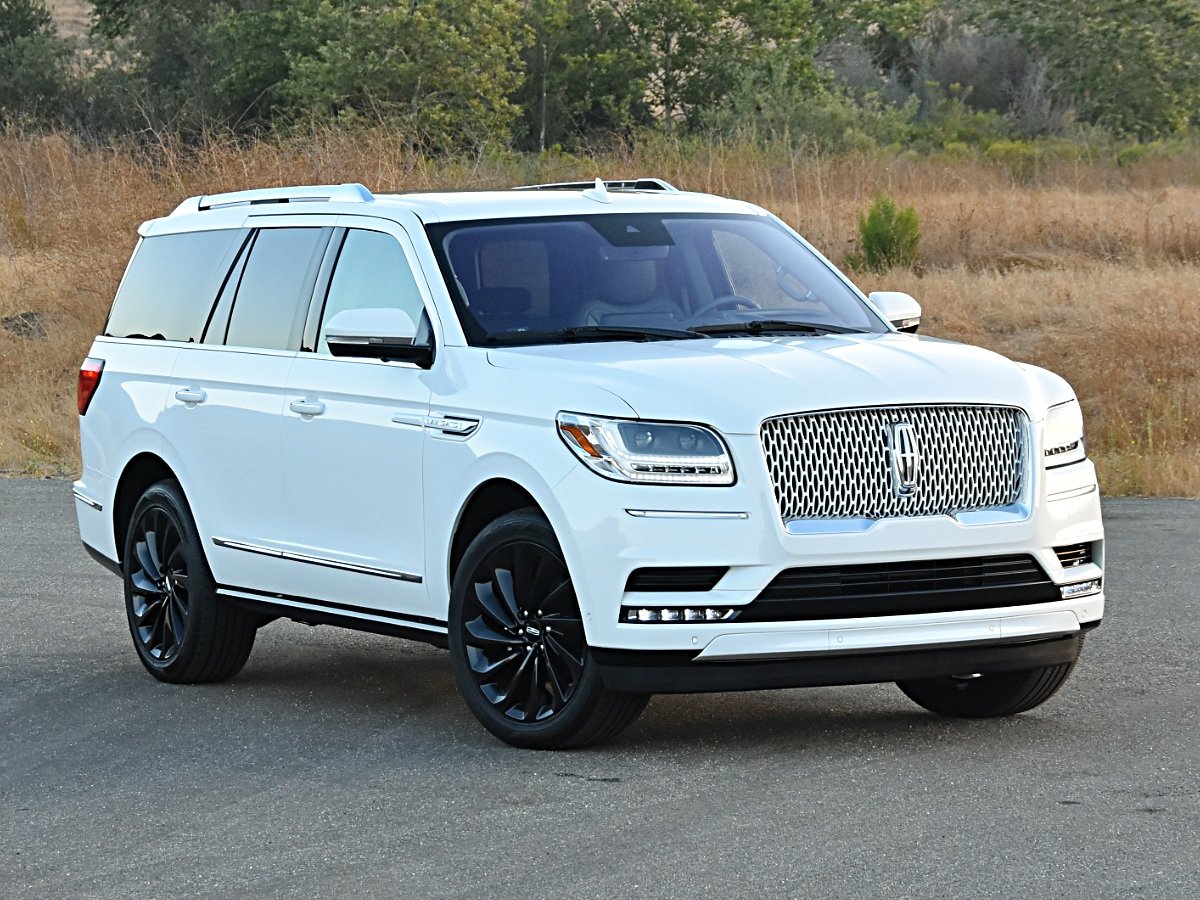
According to CarGurus experts, the overall rating for the 2020 Lincoln Navigator is 8.2 out of 10, while the 2021 Lincoln Navigator scores 7.7 out of 10. Based on these ratings, the 2020 Lincoln Navigator is the preferable choice. It excels in providing a more engaging driving experience, extensive luxury options, and unmatched cargo capacity, all essential for a luxurious flagship SUV. The 2021 model, though modern and stylish, falls short in areas crucial for a premium vehicle in this segment.
Choose the 2021 Lincoln Navigator if:
- You desire a more refined and understated design, with a focus on elegant simplicity and premium materials.
- You appreciate advanced interior comfort features, such as individualized seat adjustments and upgraded climate control options.
- You want modern technology features like wireless device charging, smartphone ignition activation, and robust rear-seat entertainment options.
Choose the 2020 Lincoln Navigator if:
- You prioritize towing capacity and a robust, reliable performance with a proven engine.
- You value the extensive luxury options like the 30-way Perfect Position front seats and custom Monochromatic package.
- You need a versatile and spacious interior with class-leading cargo capacity, ideal for family trips and long drives.
CarGurus highlights

According to CarGurus experts, the overall rating for the 2020 Lincoln Navigator is 8.2 out of 10, while the 2021 Lincoln Navigator scores 7.7 out of 10. Based on these ratings, the 2020 Lincoln Navigator is the preferable choice. It excels in providing a more engaging driving experience, extensive luxury options, and unmatched cargo capacity, all essential for a luxurious flagship SUV. The 2021 model, though modern and stylish, falls short in areas crucial for a premium vehicle in this segment.
Choose the 2021 Lincoln Navigator if:
Shop Now- You desire a more refined and understated design, with a focus on elegant simplicity and premium materials.
- You appreciate advanced interior comfort features, such as individualized seat adjustments and upgraded climate control options.
- You want modern technology features like wireless device charging, smartphone ignition activation, and robust rear-seat entertainment options.
Choose the 2020 Lincoln Navigator if:
Shop Now- You prioritize towing capacity and a robust, reliable performance with a proven engine.
- You value the extensive luxury options like the 30-way Perfect Position front seats and custom Monochromatic package.
- You need a versatile and spacious interior with class-leading cargo capacity, ideal for family trips and long drives.

By: CarGurus + AI
At CarGurus, our team of experienced automotive writers remain at the heart of our content operation, conducting hands-on car tests and writing insightful guides that are backed by years of industry experience. To complement this, we are harnessing AI to make our content offering more diverse and more helpful to shoppers than ever. To achieve this, our AI systems are based exclusively on CarGurus content, ratings and data, so that what we produce is both unique to CarGurus, and uniquely helpful to car shoppers.











